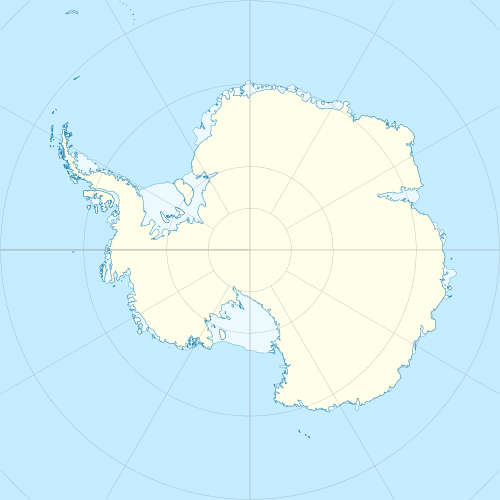Snow Hill Island
 Snow Hill Island, January 1999 | |
 Snow Hill Island | |
| Geography | |
|---|---|
| Location | Antarctica |
| Coordinates | 64°28′S 57°12′W / 64.467°S 57.200°WCoordinates: 64°28′S 57°12′W / 64.467°S 57.200°W |
| Archipelago | James Ross Island group |
| Length | 33 km (20.5 mi) |
| Width | 12 km (7.5 mi) |
| Administration | |
|
None | |
| Demographics | |
| Population | 0 |
| Additional information | |
| Administered under the Antarctic Treaty System | |
Snow Hill Island is an almost completely snowcapped island, 33 km (21 mi) long and 12 km (7.5 mi) wide, lying off the east coast of the Antarctic Peninsula. It is separated from James Ross Island to the north-east by Admiralty Sound. It is one of several islands around the peninsula known as Graham Land, which is closer to South America than any other part of the Antarctic continent.[1]
History
The island was discovered on 6 January 1843 by a British expedition under James Clark Ross who, uncertain of its connection with the mainland, named it Snow Hill because its snow cover stood out in contrast to the bare ground of nearby Seymour Island. Its insular character was determined in 1902 by the Swedish Antarctic Expedition in the ship Antarctic, under Otto Nordenskiöld, who spent the winters of 1901, 1902, and 1903 there, using it as a base to explore the neighbouring islands and the Nordenskjold Coast of the Antarctic Peninsula.[2]
Historic site

The wooden hut built by the main party of the Swedish Expedition in February 1902, also known as Nordenskiöld House, has been designated a Historic Site or Monument (HSM 38), following a proposal by Argentina and the United Kingdom to the Antarctic Treaty Consultative Meeting.[3]
Important Bird Area
A site at the south-western extremity of the island, comprising 263 ha of sea ice adjacent to the coast, has been identified as an Important Bird Area (IBA) by BirdLife International because it supports a breeding colony of about 4000 pairs of emperor penguins. It is one of only two such colonies on land in the Antarctic Peninsula region, the other being that at the Dion Islands.[4]
See also
References
- ↑ ESA Science & Technology: Graham Land
- ↑ Stonehouse (2002)
- ↑ "List of Historic Sites and Monuments approved by the ATCM (2012)" (PDF). Antarctic Treaty Secretariat. 2012. Retrieved 2013-12-31.
- ↑ "Snow Hill Island". BirdLife data zone: Important Bird Areas. BirdLife International. 2013. Retrieved 2013-01-19.
- Antarctica. Sydney: Reader's Digest, 1985, pp. 152–159..
- Child, Jack. Antarctica and South American Geopolitics: Frozen Lebensraum. New York: Praeger Publishers, 1988, pp. 69, 72.
- Lonely Planet, Antarctica: a Lonely Planet Travel Survival Kit, Oakland, CA: Lonely Planet Publications, 1996, 307.
- Stewart, Andrew, Antarctica: An Encyclopedia. London: McFarland and Co., 1990 (2 volumes), p 931.
- Stonehouse, Bernard. Encyclopedia of Antarctica and the Southern Oceans, John Wiley and Sons, 2002. ISBN 0-471-98665-8
- U.S. National Science Foundation, Geographic Names of the Antarctic, Fred G. Alberts, ed. Washington: NSF, 1980.
![]() This article incorporates public domain material from the United States Geological Survey document "Snow Hill Island" (content from the Geographic Names Information System).
This article incorporates public domain material from the United States Geological Survey document "Snow Hill Island" (content from the Geographic Names Information System).